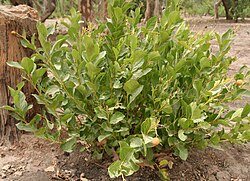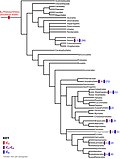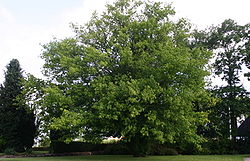The APG III system of flowering plant classification is the third version of a modern, mostly molecular-based, system of plant taxonomy being developed...
47 KB (3,194 words) - 23:22, 30 November 2024
was replaced by the improved APG II in 2003, APG III system in 2009 and APG IV system in 2016. The original APG system is unusual in being based, not...
20 KB (1,426 words) - 19:08, 1 June 2024
(APG). It was published in 2016, seven years after its predecessor the APG III system was published in 2009, and 18 years after the first APG system was...
40 KB (2,558 words) - 15:03, 19 September 2024
published in 1998, and was superseded in 2009 by a further revision, the APG III system. APG II was published as: Angiosperm Phylogeny Group (2003). "An update...
7 KB (651 words) - 08:44, 20 October 2024
three plant families. Under the APG III system, the Asparagaceae contain seven subfamilies, and unlike the APG II system, Asparagaceae was only circumscribed...
27 KB (1,368 words) - 22:11, 23 May 2025
flowering plants. The name is newly accepted in the APG III system of plant taxonomy. APG II system, of 2003, mentions the possibility of recognizing the...
2 KB (193 words) - 16:17, 25 April 2024
flowering plants. The order did not exist in the 2009 APG III system, and was added in the 2016 APG IV system, including two families, Icacinaceae and Oncothecaceae...
2 KB (162 words) - 01:53, 25 May 2025
flowering plants, included within the asterid group of dicotyledons. In the APG III system of 2009, the order includes only two families, Adoxaceae and a broadly...
3 KB (263 words) - 04:40, 8 April 2024
Angiosperm Phylogeny Group (section APG III (2009))
revisions have been published, in 2003 (APG II), in 2009 (APG III) and in 2016 (APG IV), each superseding the previous system. Thirteen researchers have been...
33 KB (3,527 words) - 15:26, 7 March 2025
potentially containing one family, Dilleniaceae. The APG III system of 2009, like the earlier APG II system of 2003, left the Dilleniaceae unplaced as to order...
2 KB (168 words) - 20:11, 4 February 2025
mangos and cashews; frankincense and myrrh; mahogany and neem. The APG III system of 2009 includes it in the clade malvids (in rosids, in eudicots) with...
5 KB (407 words) - 02:32, 13 November 2024
"lizard's-tail family". The APG IV system (2016; unchanged from the 2009 APG III system, the 2003 APG II system and the 1998 APG system) assigned it to the order...
4 KB (333 words) - 03:22, 8 April 2024
Angiosperm Phylogeny Group (APG II) both families are unplaced to order, but nevertheless included in the Eurosids I. The APG III system of 2009, however, recognized...
5 KB (334 words) - 16:16, 7 September 2024
of the PhyloCode system of phylogenetic nomenclature. While such a clade with a similar circumscription exists in the APG III system, it was not given...
12 KB (1,182 words) - 02:18, 20 April 2025
Liliopsida (section Liliopsida in the Takhtajan system)
Reveal system). subclass Liliidae in the Dahlgren system and the Thorne system (1992) clade monocots in the APG system, the APG II system and the APG III system...
7 KB (675 words) - 22:54, 1 October 2023
tree. Myrtales include the following nine families, according to the APG III system of classification: Alzateaceae Combretaceae (leadwood family) Crypteroniaceae...
8 KB (672 words) - 21:41, 18 February 2025
APG IV (2016). The botanical name has been recognized by most taxonomists. The APG III system of 2009 recognized the family, as did the APG II system...
3 KB (262 words) - 06:44, 13 December 2024
Myrsinaceae in 2000 and finally, in 2009 with the introduction of the APG III system, was returned to the subfamily Myrsinoideae within the family Primulaceae...
27 KB (2,643 words) - 03:08, 6 April 2025
in its own order Huales. The APG II system placed it in the clade eurosids I, whereas the APG III system of 2009 and APG IV (2016) place it within the...
3 KB (244 words) - 01:52, 31 May 2025
widely used system of plant classification, the Angiosperm Phylogeny Group's APG III system. The order was comprised differently in various systems of plant...
3 KB (317 words) - 04:34, 8 April 2024
by other taxonomic systems. The APG II system recognized the family as containing a single genus, Pterostemon. The APG III system of 2009, as well as...
1 KB (85 words) - 03:53, 7 April 2024
system placed the Turneracids in the order Violales, but it is not currently recognized as a family by the Angiosperm Phylogeny Group in the APG III system...
2 KB (232 words) - 02:54, 8 April 2024
modern treatment, however, the APG III system of 2009 (unchanged from the 2003 APG II system and the 1998 APG system), places the family in the order...
6 KB (505 words) - 09:34, 18 May 2024
recognized in a number of systems of plant taxonomy. The Illiciaceae is not recognized as a distinct family by the APG III system of plant taxonomy, the...
5 KB (549 words) - 03:28, 8 April 2024
of flowering plants. The APG III system places it in the order Dioscoreales, in the clade monocots. As circumscribed by APG IV (2016) it includes 35 species...
4 KB (216 words) - 13:55, 28 May 2025
Trimeniaceae (section APG III)
as being among the most basal lineages in the clade angiosperms. The APG III system, of 2009, also recognizes such a family and places it in order Austrobaileyales...
4 KB (440 words) - 02:50, 8 April 2024
comprise the two families Aextoxicaceae and Berberidopsidaceae. The APG III system of 2009 formally recognized the order Berberidopsidales and placed Aextoxicaceae...
2 KB (221 words) - 04:05, 8 April 2024
and on this page the structure of the order is used according to the APG III system. The order takes its name from the family Asparagaceae and is placed...
39 KB (4,304 words) - 03:10, 8 April 2024
classification schemes. Under the 2009 APG III system the Francoaceae were included within the Melianthaceae. In the 2016 APG IV system the Francoaceae are again recognized...
2 KB (228 words) - 21:22, 1 May 2025
compound leaves. The APG IV system of 2016 (unchanged from the earlier 1998 APG system, the 2003 APG II system, and the APG III system of 2009) includes...
3 KB (280 words) - 13:44, 14 May 2024

























